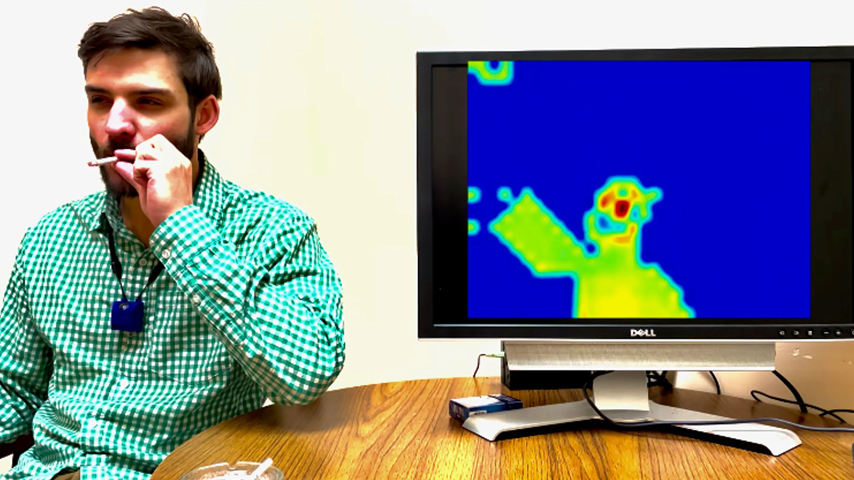Smart Necklace Helps Users Stop Smoking
Smart Necklace Helps Users Stop Smoking


What appears as an unobtrusive necklace is a smart device that captures a wearer’s unique smoking profile and intervenes when relapse is possible.
Smoking is the leading cause of preventable disease, disability, and death in the United States, according to the Centers for Disease Control and Prevention (CDC). But with 12.5 percent of adults in the U.S. being smokers, or approximately 30.8 million people as of 2020, per the CDC, finding ways to encourage and help smokers quit is a complex pursuit. Researchers at Northwestern University have developed one solution.
SmokeMon is a smart necklace that measures and collects data on smokers as they go about their days. The lapis blue pendant is described by researchers as a “chest-worn thermal-sending wearable system that can capture information about the wearer by unobtrusively and passively detecting smoking events.”
The information returned in real time can monitor a person’s smoking and hold them accountable as they try to quit. It could even be used to create smoking cessation programs.
“This goes way beyond how many cigarettes a person smokes per day,” said senior investigator Nabil Alshurafa, associate professor of preventive medicine at Northwestern University’s Feinberg School of Medicine.
Similar Reading: Self-Powered, Wireless Sensing Platform May Take Wearable Electronics to the Next Level
These details are called smoking topography, which can be aggregated and analyzed to help smokers in general as well as the individuals wearing the necklace, Alshurafa said.
“This goes way beyond how many cigarettes a person smokes per day,” he added. “We can detect when the cigarette is being lit, when the person holds it to their mouth and takes a puff, how much they inhale, how much time between puffs and how long they have the cigarette in their mouth.” In addition, the device captures spatial, temporal, and thermal information about and around the wearer.
The open-platform data analysis software behind SmokeMon measures smoking behavior in “free-living situations” to follow smoking habits in the real world. For instance, by analyzing wearers’ data, scientists can better understand the relationship between chemical exposure and tobacco-related diseases like cancer, stroke, lung disease, and diabetes, Alshurafa said.
Researchers trained a deep learning-based machine model to detect how and when users smoked along with details such as the number, duration, and volume of each puff. The SmokeMon necklace also establishes a unique smoking profile for each user.
In addition to the extensive data the device provides on smokers overall, the information gathered can also help individual wearers stop smoking by understanding how their smoking habits relate to their own relapse. Behavior patterns after smoking cession, leading up to a relapse, and in the middle of a relapse are all gathered.
One example the researchers provided noted that if an individual stopped smoking, then typically relapsed after taking five puffs of a cigarette, the device would learn from this. So, after that person took four puffs of a cigarette, the device may send a text or video message, or connect the person with a health coach directly, warning that the user may be close to relapse.
Become a Member: How to Join ASME
“A person can learn from slips, by gaining awareness that they did not fail, they just had a temporary setback,” Alshurafa said. “To avoid a smoking relapse, we can then begin to shift their focus to how they handle their triggers and deal with cravings.”
While other devices do exist to track smoking topography, they typically need to be attached to a cigarette, which makes people aware of their smoking habits and makes the data less reliable. Other devices are embedded within a smart device worn on the wrist, but they often accidentally measure non-smoking hand-to-mouth gestures, which also makes the data less reliable, Alshurafa said.
The scientists also plan to study the effectiveness of the device in detecting smoking puffs and topography from electronic cigarettes.
“We want to catch smokers before they completely fall off the wagon. Once they do, it’s much harder for them to quit again,” Alshurafa said.
Jean Thilmany is a science and technology writer in Saint Paul, Minn.
SmokeMon is a smart necklace that measures and collects data on smokers as they go about their days. The lapis blue pendant is described by researchers as a “chest-worn thermal-sending wearable system that can capture information about the wearer by unobtrusively and passively detecting smoking events.”
The information returned in real time can monitor a person’s smoking and hold them accountable as they try to quit. It could even be used to create smoking cessation programs.
“This goes way beyond how many cigarettes a person smokes per day,” said senior investigator Nabil Alshurafa, associate professor of preventive medicine at Northwestern University’s Feinberg School of Medicine.
Similar Reading: Self-Powered, Wireless Sensing Platform May Take Wearable Electronics to the Next Level
These details are called smoking topography, which can be aggregated and analyzed to help smokers in general as well as the individuals wearing the necklace, Alshurafa said.
“This goes way beyond how many cigarettes a person smokes per day,” he added. “We can detect when the cigarette is being lit, when the person holds it to their mouth and takes a puff, how much they inhale, how much time between puffs and how long they have the cigarette in their mouth.” In addition, the device captures spatial, temporal, and thermal information about and around the wearer.
The open-platform data analysis software behind SmokeMon measures smoking behavior in “free-living situations” to follow smoking habits in the real world. For instance, by analyzing wearers’ data, scientists can better understand the relationship between chemical exposure and tobacco-related diseases like cancer, stroke, lung disease, and diabetes, Alshurafa said.
Researchers trained a deep learning-based machine model to detect how and when users smoked along with details such as the number, duration, and volume of each puff. The SmokeMon necklace also establishes a unique smoking profile for each user.
In addition to the extensive data the device provides on smokers overall, the information gathered can also help individual wearers stop smoking by understanding how their smoking habits relate to their own relapse. Behavior patterns after smoking cession, leading up to a relapse, and in the middle of a relapse are all gathered.
One example the researchers provided noted that if an individual stopped smoking, then typically relapsed after taking five puffs of a cigarette, the device would learn from this. So, after that person took four puffs of a cigarette, the device may send a text or video message, or connect the person with a health coach directly, warning that the user may be close to relapse.
Become a Member: How to Join ASME
“A person can learn from slips, by gaining awareness that they did not fail, they just had a temporary setback,” Alshurafa said. “To avoid a smoking relapse, we can then begin to shift their focus to how they handle their triggers and deal with cravings.”
While other devices do exist to track smoking topography, they typically need to be attached to a cigarette, which makes people aware of their smoking habits and makes the data less reliable. Other devices are embedded within a smart device worn on the wrist, but they often accidentally measure non-smoking hand-to-mouth gestures, which also makes the data less reliable, Alshurafa said.
The scientists also plan to study the effectiveness of the device in detecting smoking puffs and topography from electronic cigarettes.
“We want to catch smokers before they completely fall off the wagon. Once they do, it’s much harder for them to quit again,” Alshurafa said.
Jean Thilmany is a science and technology writer in Saint Paul, Minn.






